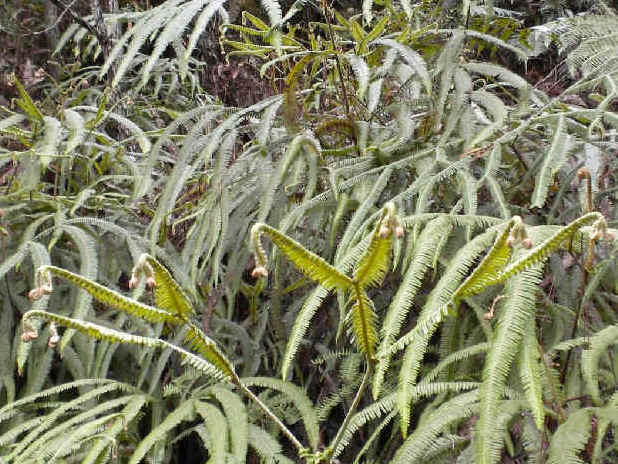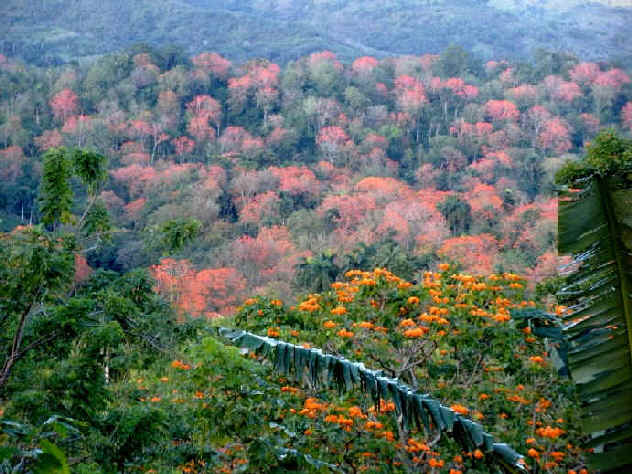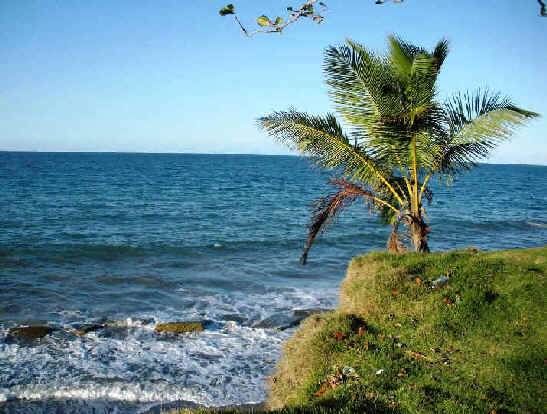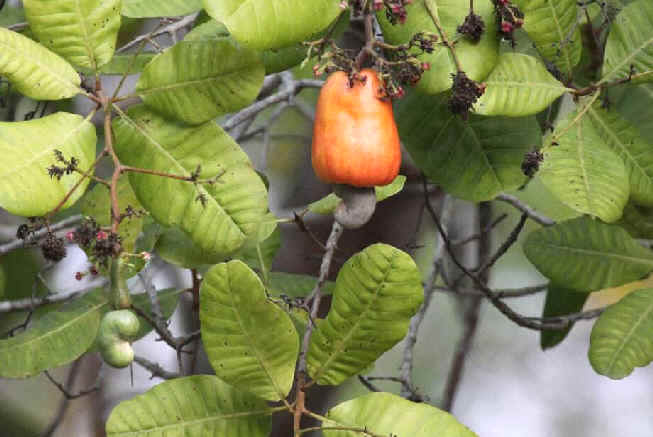 |
PO
Box 9021, Wilmington, DE 19809, USA
E-mail: font@focusonnature.com
Phone: Toll-free in USA 1-800-721-9986
or 302/529-1876 |
 Hispaniolan
Hispaniolan
Plant Life
with those during
Focus On Nature Tours
in the Dominican Republic
noted with an (*)
1990 thru 2014
during the months of January,
February, March, April, July,
& December
This list compiled by Armas Hill
Upper right photo: some of the plants, with ferns and fiddleheads,
at about 7,500 feet above sea level
in the Cordillera Central in the Dominican Republic
(photographed during a FONT tour by Rise
Hill)
There have been 18 FONT birding & nature tours in the Dominican Republic.

African Tulip Trees were
introduced in the Dominican Republic years ago.
Here, a large group of them in bloom in the northern hills of Hispaniola.
Links:
A Photo Gallery of Dominican Republic Plant Life,
including some about a male and a half above sea level & some below sea
level
A List & Photo Gallery of Caribbean Birds, in 2 Parts
Butterflies
& Moths of the Caribbean (with some photos)
Nature in the Dominican Republic, including: Mammals, Amphibians, Reptiles,
Snails, Crabs, Butterflies & Moths, Dragonflies & Damselflies, and
Others
Upcoming FONT Birding
& Nature Tours in the Caribbean
Directory of Photos in this Website

A List of Selected Plant-life of Hispaniola:
Plants
in the HIGHLANDS
where there are mountains as high as over
10,000 feet above sea level
- Hispaniolan Pine (or Pino Criollo) (He) (*) ______
(common in lateritic soils)
Pinus occidentalis
- Sabina ______
Juniperus gracilior
- Podocarpus
aristulatus
(or buchii) ______
- Cara de Hombre ______
Lyonia spp.
- Abey ______
Cojoba arborea
- Yaya Fina ______
Oxandra lanceolata
- Pajon ______
Danthonia domingensis
- Verbena
officinalis ______
- Weinmannia pinnata
______
In the highlands, as elsewhere, in wet
forests, trees are covered with parasitic plants and epiphytes.
At higher elevations, characteristic species are:
- Trembling Schefflera ______
Scheflera tremula
- Black Sapote ______
diospyros digyna
- Almendron ______
Prunus occidentalis
- Fadyen's Silktassel ______
Garrya fadyenii
- Oreopanax capitatus
______
- Brunellia comocladifolia
______
- Cyathea spp.
______
Some
Characteristic Lowland Plants of HISPANIOLAN MOIST FORESTS
- Haitian Catalpa ______
Catallpa longissima
- West Indian Mahogony ______
Swietenia mahagoni
- Puerto Rican Royal Palm (ph) ______
(common where the soil is calcareous)
Roystonea borinquena

A lone Royal Palm along the north coast of the Dominican Republic
(photographed during a FONT tour in February 2012)
- Paradise Tree ______
Simarouba glauca
- Anon de Majagua ______
Lonchocarpus heptaphyllus
- Jagua ______
Genipa americana
- Black Olive ______
Bucida buceras
- West Indian Lancewood ______
Oxandra lanceolata
- Amacey ______
Tetragastris balsamifera
As
isolated trees, or with them, these are found:
- Fustic ______
Maclura tinctoria
- Logwood ______
Haematoxylum campechianum
- Iris ______
Hippeastrum punicetum
- Caracoli
______
Abarema glauca
- Corbano
______
Albizia berteriana
- West Indian
Elm ______
Guazuma ulmifolia
- Palo de Leche
______
Rauvolfia
nitida
- Spiny Fiddlewood
______
Citharexylum spinosum
Where
soils are poor or in savannas that have formed from degraded
forest:
- Sandpaper Tree ______
Curatella americana
- Grandleaf Seagrape ______
Coccoloba pubescens
- Jamaica Nettletree ______
Trema micrantha
- Tabebula
spp. ______
- Cashew (ph) _____ (where
there is marginal earth and with precipitation closer to that of dry
forests)
Anacardium occidentale

The fruit on a Cashew Tree photographed during a FONT tour
(photo by Marie Gardner)
Plants that grow in Mesic forests:
- Yellow Oliver ______
Buchenavia capitata
- Sablito ______
Schefflera morototoni
- Maricao ______
Byrsonima spicata
- Aguacatillo ______
Alchornea latifolia
- West Indian Cherry ______
Prunus myrtifolia
- Arbol de Santa Maria ______
Calophyllum basiliense
- Cocuyo ______
Hirtella triandra
- American Muskwood ______
Guarrea guidonia
- Palo de Yagua ______
Casearia arborea
- locust ______
Hymenaea courbaril
- Balata ______
Manilkara domingensis
- Sierra Palm ______
Prestoea montana
To
Top of Page



 Hispaniolan
Hispaniolan
![]()


![]()